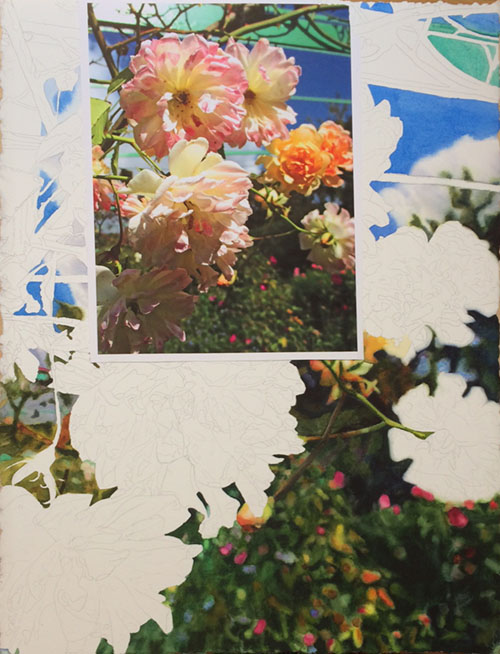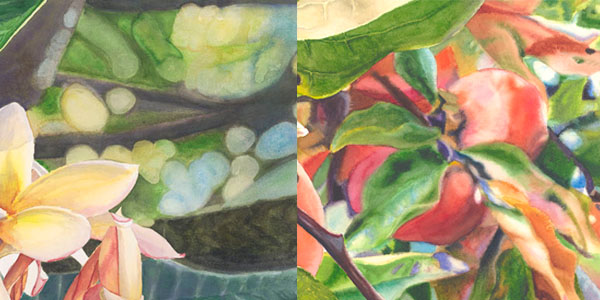June 14, 2017 – Learning to paint fuzzy
- At June 14, 2017
- By Cara
- In Life Stories


The painting I’m working on – I got the hard part done first – the fuzzy background. I still don’t find them easy!
Do you ever wonder who ate the first artichoke? Who saw this prickly, thistly thing and thought it would be edible? I ask myself these questions all the time – appreciating having been born in a time when so much has already been figured out! I think of all the people who perished by eating poisonous things – before we had ways of knowing what was poisonous versus what would provide the nutrition we need to stay alive. It’s no small thing! In the time of human history – which has just been determined to be another hundred million years older than previously thought – there has been a vast body of knowledge acquired. And with the advent of the Internet during the tiniest last bit of that history, a huge part of all this knowledge is available with a few taps on a keyboard. It’s mind boggling! As a student of how we learn I see the part that information plays – but it only just cracks open the door to learning how to do something.
It seems there are (at least) two kinds of learning – either we gain information via reading, listening or watching, or we have to plunge in and do something. I’m a compulsive learner – especially the information gathering kind. I love knowing just for the sake of knowing and I also know it can take me over! I love the other kind of learning too – though it does not come nearly as easily. I find it empowering to have skills. I’ve learned to use knives in the kitchen, to set ceramic tile, to handle plants in the garden, to make my own clothes, embroidery stitching, cross stitch and needle point – though I can’t handle knitting needles for beans! I find it very satisfying to be able to do things with my hands. It’s no surprise then that I ended up doing something tactile, making these paintings. The thing about learning a skill is that it’s not as easy as running your eyes across words, you have to move your muscles and interact with stuff – with materials in the physical world.
Sally Ragusa, someone who is dear to me, is a student of mine from Arizona – she came all the way here to Larkspur to take the color workshop last year. As I’ve been painting my way through this pretty intricate “fuzzy background” in the past week I have had Sally’s voice in my head – asking me to teach how to paint out of focus. The truth is as much as I can describe what I do, with every single one of these backgrounds I find my way through. It’s not just one technique I follow throughout. Sometimes I do one thing sometimes I do the opposite. So, Sally, here goes. I’ll describe what I’ve observed.
- First off, there is the physical-ness of paint and water. I’ve come to see, even visualize in my head, how the paint is a whole bunch of particles. In a light, thin wash, there are a relatively small amount of particles suspended in the water, and a thick, heavy layer of paint has just enough water to make lots of particles fluid. Thick washes have more capacity to push than a thin wash – more particles, more “muscle.”
- Next you must know that it’s all about the water, how much and where it is: on the brush, on your paper and in the wash on the palette. The late artist and teacher Susan Adams used the analogy of tea, milk and cream. The more water the more movement and the less control you have.
- Remember this: the water will always flow from where it is to where it isn’t – on the brush, paper and palette.
- The caveat to this is that without a minimum amount of water it won’t flow at all. Just as a damp, wrung out sponge is much more absorbent than a dry sponge, if you want to use your brush to lift some water off your paper, it works best if your brush is a bit damp. If you want your paint to flow onto your paper, it must be at least somewhat damp, otherwise it takes the brush to move it around.
- The whole idea with painting fuzzy is to create a narrow transition where the particles of paint taper off from a more concentrated application – such that you have no hard edges, while still controlling the contours of the shapes.
With these fundamentals in mind, here’s what I find myself doing:
- Paint a very concentrated, heavy wash with a small brush (I use a 6 most often) with little water onto damp paper.
- Then sometimes I use a clean, damp brush to lift or “reshape” the paint while it is still wet.
- Paint a shape on dry paper then clean my brush and run a damp brush along the edge of the shape, washing my brush frequently as I go.
- Paint “wet next to wet” by painting a shape and then right away painting another shape in a different color right next to it, so that the pigments can blend. This works best when both are relatively similar concentrations of paint. If one is thick and the other thin, the delineation between them won’t be as clear – one will spill into the other.
- Paint light colors first, knowing that when I paint an adjacent darker color I can soften the edge of the darker shape.
- Paint dark colors first, softening all edges, taking care to not stain (too much!) the areas that will be light in color.
- Use a more stiff brush (such as one I’ve worn the tip off of ) to lift out shapes from a dry wash – I do this often to make what I call “light bubbles.”
- Use a scrubber to erode the sharp edge of a shape that has dried hard – one that got away from me. It doesn’t take too much scrubbing to have the edge look soft. Note that this has the tendency to scuff up the tooth of the paper which impacts how new layers of paint will appear. It also has my painting look “scrubbed” and lately I’ve been working on avoiding using scrubbers if at all possible.
- Layer over using any and all of these ideas when what I’ve done on the first past isn’t “there” yet – after the first layer has dried.
Painting this way is a challenge – it can be even frustrating. But know it’s possible to learn how. I look at my earliest fuzzy backgrounds and see an enormous difference from what I can do now. And I’ve witnessed the same evolution in several of the artists in our groups – those who have been intent on practicing it – which is what it takes to learn a skill. You can’t just read about it. Though I hope that reading what I’ve described about painting “fuzzy” is helpful – I hope it can to get you started. But ultimately, it’s a solo journey. Your hand has to be on the brush dipping into the water and paint, putting it on the paper to see what happens with each variable – of paint, water, brush size and stiffness, and drying time. The other thing it takes is patience with yourself. I’ve painted dozens and dozens of fuzzy backgrounds and I still feel adrift. Ours is a wild medium, one that doesn’t take to being readily tamed.
But painting in watercolor is home to me. I’ll spend the rest of my life – as long as my hands, eyes and brain allow me to – in partnering with this medium to bring beauty to life. One of the things that keeps me going is knowing you are right here with me.
Love,
Cara

